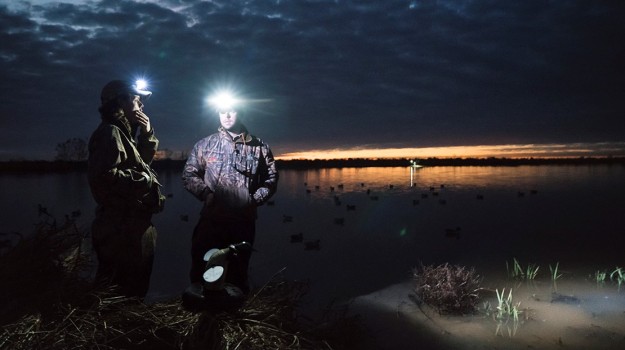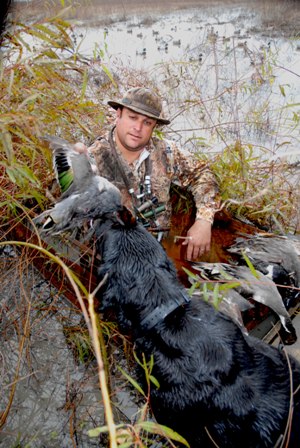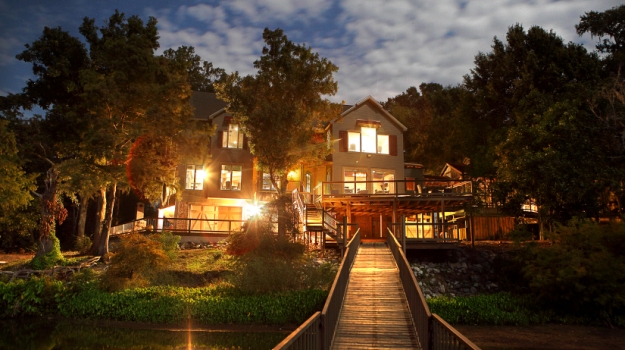
At the first of this 2016 season, the U.S. Fish and Wildlife Service folks came in and did their annual duck count. They were very excited. They said that Louisiana was holding more ducks statewide than the state ever had had since 1910. Their count was more than 3-million ducks in Louisiana for the first week of duck season. Our first split season started November 19, 2016, and ended December 4, 2016. We've had one blind in the last 3 years that has shot all 14 species of ducks that we have here. People who hunt here see mallards, teal, wigeons, gadwalls, shovelers, scaups, a few canvasbacks and lots and lots of pintails.
We hunt from two to four people in each blind. Opening day was a duck hunter’s dream. The night before opening day, a storm came through our area, and the temperature dropped 40 degrees. We had a cold north wind when we arrived at the blind, and everybody was back at the lodge really early. Some of our hunters were back in the lodge eating breakfast by 7:30 am. The next morning on Sunday, we had a bluebird north wind day after the front, and some of our blinds didn’t limit-out until 10:30 am. We hunt until our hunters either get a limit of ducks or until 11:00 am each day.
But how quickly we get back from the blinds is also dependent on another factor. Our hunters may limit out early, because they're excited about taking ducks. However, often on the second day, they’ll become very selective, because they may want to take pintails or mallards exclusively, or some other duck that they rarely see where they usually hunt. So, they may let 50 or 100 ducks fly within gun range and not take a shot, if they don’t see the particular duck they want to take. However, as we get closer to 10:00 am, our hunters aren’t nearly as picky as they are at daylight. If you want to limit-out on teal, and you can shoot accurately, you can limit-out every day here at Honey Brake on teal. Last year, 42 percent of the ducks we harvested were mallards, 18 percent gadwalls and then the rest was a wide variety of other ducks.
I'm often asked, “What are you expecting for the second duck season?” When I think about the second duck season this year, I have to laugh, because right after we had to pump a lot of water into our waterfowl areas due to the drought, our property received 10 inches of rain over about a 5-day period. Now, we have plenty of water in our wetlands. We’ve actually had to let some water out.
 This past week, we had weather in the 20-degree range, which is highly unusual for Louisiana in December. Right now in mid-December, 2016, we’re loaded with ducks. One of the reasons I think we’re going to have such a good second duck season is because now we’ll get yo-yo ducks. When a hard-pushed cold front comes in from the north, we’ll get new ducks from the north. However, since we’re in the heart of the Mississippi Flyway, when there's a hard push of warm wind from the south, we get ducks coming back up from the south. About every week or two, we’ll either get a north wind or a south wind, and Honey Brake will get a new flight of ducks that hasn’t been shot at yet. However, when the temperature is in the mid-40s, we’re the most successful, because that’s our normal temperature during duck season. So, if the temperature gets warmer, we’ll generally have more ducks. But you never know. Until last year, we hadn’t had snow in 12 years. Last year we had snow twice. However, we don’t get those big snows like they do up north. If we just get white stuff on the ground, regardless of how long it stays, that’s a big deal in Louisiana. One thing for certain is if you’re concerned about global warming, when snow falls in Louisiana, the world hasn’t gotten too warm.
This past week, we had weather in the 20-degree range, which is highly unusual for Louisiana in December. Right now in mid-December, 2016, we’re loaded with ducks. One of the reasons I think we’re going to have such a good second duck season is because now we’ll get yo-yo ducks. When a hard-pushed cold front comes in from the north, we’ll get new ducks from the north. However, since we’re in the heart of the Mississippi Flyway, when there's a hard push of warm wind from the south, we get ducks coming back up from the south. About every week or two, we’ll either get a north wind or a south wind, and Honey Brake will get a new flight of ducks that hasn’t been shot at yet. However, when the temperature is in the mid-40s, we’re the most successful, because that’s our normal temperature during duck season. So, if the temperature gets warmer, we’ll generally have more ducks. But you never know. Until last year, we hadn’t had snow in 12 years. Last year we had snow twice. However, we don’t get those big snows like they do up north. If we just get white stuff on the ground, regardless of how long it stays, that’s a big deal in Louisiana. One thing for certain is if you’re concerned about global warming, when snow falls in Louisiana, the world hasn’t gotten too warm.
In the early season, we’ll have numbers of teal, pintails and quite a few mallards. But in the late season, we’ll see more mallards, some black ducks and big pushes of scaup, canvasbacks and ring-necks. Even in the early season, we may have 30 teal lighting in the decoys waiting on the pintails and mallards to arrive.
Some of our hunters get real greedy. For instance last Sunday, we had two mallard drakes drop into our decoy spread. Our hunters wouldn’t shoot them, because 25 more mallards were coming to the blind behind those first two. When the flight of 25 turned away from the blind, the two mallards sitting on the water flew off. So, our hunters didn’t take any mallards from that flight, and they easily could have taken those two drake mallards as they were coming in to the decoys.
Because Honey Brake has so many ducks right now, I can go out just about any morning and get a limit of pintails and mallards and watch the rest of the ducks fly past my blind.
In the late season, our hunters may be hunting in an area with three or four blinds in a 500 - 900 acre shallow water impoundment. From 5,000 to 10,000 ducks may be working that shallow water place, and those ducks may fly in one big wave, or they may fly in groups from 2 - 20.
I'm often asked about goose hunting. Even if we have two or three specklebelly geese (white-fronted geese) decoys in our spread, we don’t really hunt geese. Our land here at Honey Brake is made up of rich, black, gumbo mud. I'm about 6-feet tall, but when I walk through a field of gumbo mud, I’ll have enough mud on the soles of my boots that I’ll probably be about 8-feet tall.
To learn more about Honey Brake Lodge, go to www.honeybrake.com; call the lodge at 318-775-1007; or email justin@honeybrake.com.
Day 1: What Is Honey Brake?



























